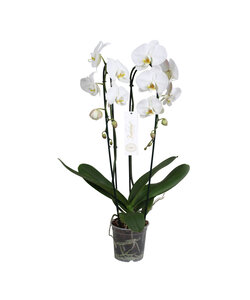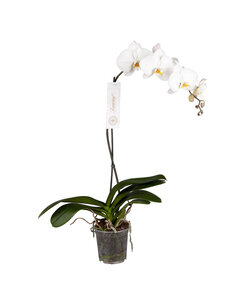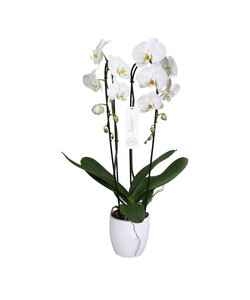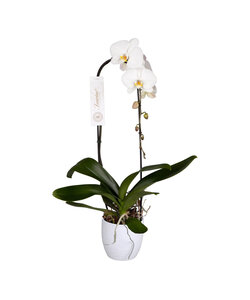
| Height (incl. pot) | ± 80 cm | |
| Pot size | 15 cm |
More information
Phalaenopsis Tsarine
Grooming
The Phalaenopsis thrives best with a minimum night temperature of 16 ° C and a maximum daytime temperature of 32 ° C. An ideal daytime temperature is between 20 to 22 ° C. This orchid requires a lot of light but cannot tolerate direct sunlight, especially in the summer months. A place on the windowsill facing the (north) east or (south) west is ideal. When leaves turn yellow, it could be a sign of too much direct sunlight. The loss of flower buds or dark green leaves indicate a possible lack of light.
Water and moisture
Do not pour the water for the orchid into the heart of the plant, but rather onto the soil in the pot. The ideal irrigation water is lukewarm with an acidity (pH) of 6-7. Rainwater is better than tap water that contains (too) much lime. Preferably water early in the day. It is even better to immerse the pot in a bucket for a minute. The orchid can then go without water for seven days.
In its natural environment, the Phalaenopsis has a high humidity. Therefore, if you want to cultivate or propagate the plant, it works best in damp places, such as a kitchen, bathroom or a conservatory.
Soil and Fertilization
It is important that the Phalaenopsis is in airy soil that provides moisture-retaining drainage. Special orchid soil, which can be purchased at most garden centers, is ideal for this. Avoid using ordinary potting soil. Because there is often little food in the airy orchid soil, it is best to fertilize the Phaelenopsis via the irrigation water. Special orchid fertilizers are available for this purpose. Fertilizing is necessary in the months of March to October, about twice a month.
After flowering
When a Phalaenopsis has finished flowering, you can try to get it back into bloom. For this it is necessary to cut the branch above the second 'eye'. This concerns thickenings on the branch. You must start counting from the bottom up.
If the Phalaenopsis develops aerial roots that will grow outside the pot, this is a sign that the orchid is having a good time. Just let the roots sit. You don't have to put them back in the pot with the risk of damaging the roots.
Phalaenopsis from the brand Tsarine for top quality











